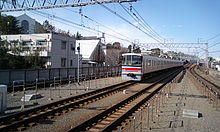Tōkyū Meguro Line
| Tokyu Meguro Line | |
|---|---|
| MG | |
 A Tokyu 3020 series train on the Meguro Line | |
| Overview | |
| Native name | 東急目黒線 |
| Owner | Tokyu Corporation |
| Locale | Tokyo |
| Termini | Meguro Hiyoshi |
| Stations | 13 |
| Service | |
| Type | Commuter rail |
| Daily ridership | 388,982 (FY 2018)[1] |
| Technical | |
| Line length | 11.9 km (7.4 mi) |
| Track gauge | 1,067 mm (3 ft 6 in) |
| Electrification | 1,500 V DC overhead catenary |
| show Tōkyū Meguro Line |
|---|

Meguro Line tracks run parallel with the Tōyoko Line between Den-en-chōfu and Hiyoshi stations (inside tracks - Meguro Line, outside tracks - Tōyoko Line)
The Tokyu Meguro Line (東急目黒線, Tōkyū Meguro-sen) is a railway line operated by Japanese private railway company Tokyu Corporation. As a railway line, the name is for the section between Meguro and Den-en-chōfu in southwest Tokyo, but nearly all trains run to Hiyoshi on a quad-tracked section of the Tōyoko Line in Yokohama, Kanagawa. Additionally, the Meguro line interoperates with the Tokyo Metro Namboku Line and Toei Mita Line beyond Meguro.
History[]
- 1923:
- 1924, June 1: Koyama becomes Musashi-Koyama.[1]
- 1926, January 1: Chōfu and Tamagawa stations are renamed to Den-en-Chōfu and Maruko-Tamagawa stations respectively.[1]
- 1928, August 1: Nishi-Koyama station opens.
- 1931, January 1: Maruko-Tamagawa station is renamed again to Tamagawa-en-mae station.[1]
- 1977, December 16: Tamagawa-en-mae station is renamed yet again to Tamagawa-en station.[1]
- 1994, November 27: Den-en-Chōfu station moves underground.
- 1997:
- June 27: Ōokayama station moves underground.
- July 27: Meguro station moves underground.
- 1999, October 10: Fudōmae station is elevated.
- 2000:
- 2001, March 28: Through service begins with the Saitama Rapid Railway line via the Namboku line.[3]
- 2006:
- 2008, June 22: Service extended to Hiyoshi.[3]
Stations[]
| No. | Station | Japanese | Express | Transfers | Location | |
|---|---|---|---|---|---|---|
| ↑ Through-running to/from the NTokyo Metro Namboku Line towards Urawa-Misono via the Saitama Rapid Railway Line ↑ ↑ Through-running to/from the IToei Mita Line towards Nishi-Takashimadaira ↑ | ||||||
| MG01 I01 N01 | Meguro | 目黒 | ● |
|
Shinagawa | Tokyo |
| MG02 | Fudō-mae | 不動前 | | | |||
| MG03 | Musashi-Koyama | 武蔵小山 | ● | |||
| MG04 | Nishi-Koyama | 西小山 | | | |||
| MG05 | Senzoku | 洗足 | | | Meguro | ||
| MG06 | Ōokayama | 大岡山 | ● | OM Tokyu Oimachi Line | Ōta | |
| MG07 | Okusawa | 奥沢 | | | Setagaya | ||
| MG08 | Den-en-chōfu | 田園調布 | ● | TY Tokyu Toyoko Line | Ōta | |
| MG09 | Tamagawa | 多摩川 | ● |
| ||
| MG10 | Shin-Maruko | 新丸子 | | | TY Tokyu Toyoko Line | Nakahara-ku, Kawasaki | Kanagawa |
| MG11 | Musashi-Kosugi | 武蔵小杉 | ● |
| ||
| MG12 | Motosumiyoshi | 元住吉 | | | TY Tokyu Toyoko Line | ||
| MG13 | Hiyoshi | 日吉 | ● |
|
Kōhoku-ku, Yokohama | |
Ridership[]
| Year | Ridership |
|---|---|
| 2010 | 321,677[4] |
| 2011 | 324,052[5] |
| 2012 | 332,590[6] |
| 2013 | 342,041[7] |
| 2014 | 347,884[8] |
| 2015 | 358,274[9] |
| 2016 | 368,386[10] |
| 2017 | 379,212[11] |
| 2018 | 388,982[1] |
Rolling stock[]
Tokyu[]
- 3000 series 6-car EMUs
- 3020 series 6-car EMUs
- 5080 series 6-car EMUs
Other operators[]
- Saitama Rapid Railway 2000 series 6-car EMUs (Saitama Rapid Railway Line)
- Toei 6300 series 6-car EMUs (Toei Mita Line)
- Tokyo Metro 9000 series 6-car EMUs (Tokyo Metro Namboku Line)
Future
- Toei 6500 series 8-car EMUs (Toei Mita Line)
- Sotetsu 20000 series 8-car EMUs (Sōtetsu Main Line or Sōtetsu Izumino Line, via the Sōtetsu Shin-Yokohama Line)
Former connecting lines[]
- Okusawa station - A 1 km 1067mm gauge line, electrified at 600 VDC, from Shin-Okusawa operated between 1928 and 1935, providing a connection to Yukigaya-Otsuka on the Tokyu Ikegami Line.
Future[]
Platforms on Meguro Line are going to be lengthened, in order to accommodate 8-car trainsets and allow through services with Sōtetsu Shin-Yokohama Line.
See also[]
References[]
- ^ Jump up to: a b c d e f g "TOKYU CORPORATION 2019-2020". Retrieved 18 Mar 2020.
- ^ Jump up to: a b "Tokyu Meguro Line". All About Japanese Trains. Retrieved 2020-03-18.
- ^ Jump up to: a b c d e f "年譜 |東急電鉄". www.tokyu.co.jp. Retrieved 2020-03-18.
- ^ "TOKYU CORPORATION 2011-2012". www.tokyu.co.jp. Retrieved 2020-03-18.
- ^ "TOKYU CORPORATION 2012-2013". www.tokyu.co.jp. Retrieved 2020-03-18.
- ^ "TOKYU CORPORATION 2013-2014". www.tokyu.co.jp. Retrieved 2020-03-18.
- ^ "TOKYU CORPORATION 2014-2015". www.tokyu.co.jp. Retrieved 2020-03-18.
- ^ "TOKYU CORPORATION 2015-2016". www.tokyu.co.jp. Retrieved 2020-03-18.
- ^ "TOKYU CORPORATION 2016-2017". www.tokyu.co.jp. Retrieved 2020-03-18.
- ^ "TOKYU CORPORATION 2017-2018". www.tokyu.co.jp. Retrieved 2020-03-18.
- ^ "TOKYU CORPORATION 2018-2019". www.tokyu.co.jp. Retrieved 2020-03-18.
External links[]
| Wikimedia Commons has media related to Tōkyū Meguro Line. |
Categories:
- Stations of Tokyu Corporation
- Lines of Tokyu Corporation
- Railway lines in Tokyo
- 1067 mm gauge railways in Japan
- Railway lines opened in 1923
- 1923 establishments in Japan